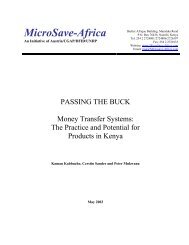Create successful ePaper yourself
Turn your PDF publications into a flip-book with our unique Google optimized e-Paper software.
Tactical deployment <strong>of</strong> grants was the most essential<br />
ingredient in the SWIFT model, because<br />
when money is targeted wisely and spent<br />
locally, it can build confidence that conditions<br />
will improve, even in the aftermath <strong>of</strong> violence.<br />
But in Indonesia at the time, as in other unstable<br />
environments, corruption was endemic. <strong>DAI</strong> and<br />
OTI took pains, therefore, to administer “inkind”<br />
grants—working with local organizations<br />
to determine needs and then paying for actual<br />
supplies and services to see that the money<br />
actually went where it should. If SWIFT placed a<br />
premium on <strong>DAI</strong>’s ability to move quickly, it also<br />
drew heavily on <strong>DAI</strong>’s considerable administrative<br />
skills.<br />
SWIFT was by far <strong>DAI</strong>’s biggest “frontier initiative”<br />
<strong>of</strong> the late 1990s and early 2000s. From<br />
Peru to Liberia, and Timor-Leste to Iraq, the firm<br />
learned how to delve deeper into the problems<br />
<strong>of</strong> transitional societies and respond more<br />
effectively to crises and opportunities. There<br />
was no formula or standard bag <strong>of</strong> tricks for<br />
achieving stabilization in troubled environments:<br />
appropriate responses might involve opening a<br />
clinic, rebuilding a town hall, or just cleaning up<br />
garbage. But the approach, as Spake put it, was<br />
consistent: work collaboratively with the citizenry;<br />
give credit to local governments; rather<br />
than taking “no” for an answer, find out where<br />
“yes” is; and understand USAID well enough to<br />
navigate through red tape while remaining accountable<br />
for the money under management.<br />
Photo by Mike Godfrey, <strong>DAI</strong><br />
Growing Pains Resurface<br />
As task orders under SWIFT got under way and<br />
other new work came on line, <strong>DAI</strong> struggled<br />
with a new set <strong>of</strong> internal challenges. Barclay’s<br />
first year as CEO got bumpier as the months<br />
passed. Up until now, an improvisational approach<br />
to management structure and systems<br />
had sufficed, and most <strong>DAI</strong> staff either attributed<br />
the company’s growth to Mickelwait’s appetite<br />
for continuous experimentation or believed<br />
that <strong>DAI</strong> had prospered despite it. Although a<br />
divisional structure was first introduced in the<br />
mid-1980s, the more informal label “group”<br />
soon took hold, and the group names, sectoral<br />
distinctions, and leadership changed <strong>of</strong>ten—<br />
especially when group leaders took up Chief<br />
In Liberia, <strong>DAI</strong><br />
projects put excombatants<br />
and<br />
war-affected<br />
people to work<br />
building community<br />
infrastructure.<br />
69



